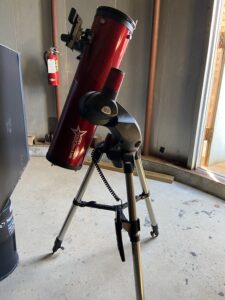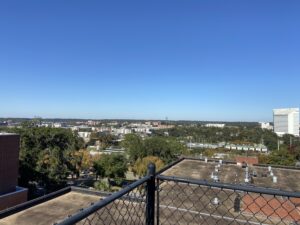
Unbeknownst to many students, there is a celestial observatory located at the top of Jones Hall. However, the telescope that was dedicated to the observatory more decades ago, has never worked since its arrival at Florida A&M University. Will it ever?
The observatory has been installed on campus for years, since before the last Halley’s comet appearance in 1986. But it is practically uncharted territory to most students coming in and out of FAMU since 2010, the last time the observatory was used after the last renovation of the Jones Hall building.
In fact, the telescope is still wrapped in its original packaging and much of it still has never been unboxed. This is because there seems to be no one in-house capable of installing the telescope safely and properly.
The telescope was requested by a former chair of the physics department and funded through Title III, which supports many things on campus such as new dorms and sports equipment.
The dilemma is that it will cost more than $50,000 to get the proper engineers to install the telescope, and although money has been flowing into the school it seems the observatory is not a high priority on FAMU’s to-do list.
“I keep asking them when will we get the money,” said B.C. Saka, chair of the physics department. “And I keep being told the money is coming, but we’re still waiting unfortunately. Any day now it can happen.”
For years the observatory has been closed to the public. However, it was not always the empty nest it is today.

Back in 1986, hundreds of people were calling the school to get access to the rooftop observatory to witness the rare sighting of Halley’s comet, which only appears every 75 years. From all over town and nearby cities, people visited FAMU to watch the phenomenon, according to Saka.
“It’s not just a physics thing,” said Sonja Richardson, the physics department’s office manager. “There are so many different celestial things going on up there and people just want to see it. With the telescope we could do that but we would need more funding.”
The question was posed if students could help bring attention to the observatory by creating petitions to get it working and running. School officials may say the observatory has not been a high priority to the university due to students’ lack of interest, but how can students be interested in something they don’t know exists?
A few other universities such as UCF and UF have installed observatories in order to give their students a new outlook on astronomy. Being able to see astronomical objects that are typically too faint to be seen with the naked eye is a peerless educational benefit. For example, Florida State students have access to get a breathtaking perspective of the stars, planets and other celestial bodies due to their operable observatory.
Undoubtedly, just as it has been done to revitalize other facilities on campus, FAMU students are known to get involved and look for changes that better the university and student life. And perhaps being more vocal about the upkeep of the school’s in-house observatory could be the right call-to-action to jumpstart the process of getting the telescope functioning.
“I’m sure students could do things such as petitions to show the university they are interested,” Saka said. “The only reason students are unaware of the facility now is because it has not been open in a long time. Maybe soon that’ll change.”